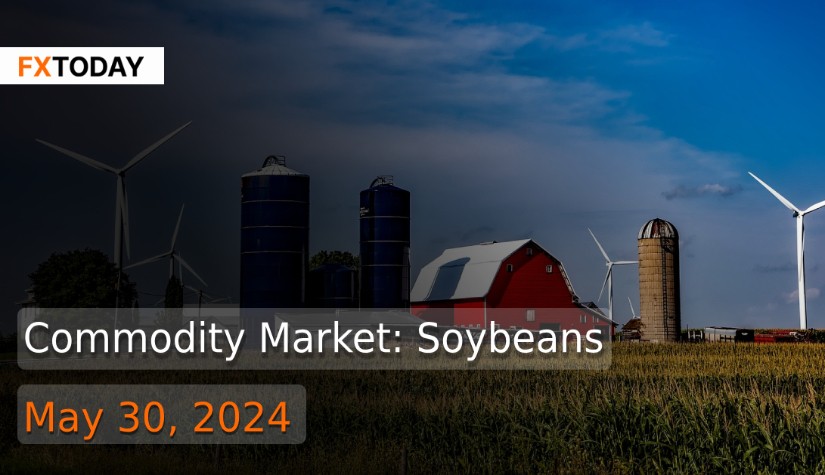Soybean Futures Drop Amid Rapid U.S. Planting Progress
Soybean and grain futures were steady overnight as investors balanced planting progress. By week's start, 68% of U.S. soybeans were planted, up from 52% a week earlier and above the five-year average of 63%.
Soybean prices dropped due to profit-taking and technical selling, despite good planting progress. Market watchers expect further progress before more rain arrives. There is speculation that delayed corn planting could increase soybean acreage. Better harvest weather in Argentina pressured soybean meal prices, as Argentina is a major exporter. Bean oil prices rose due to product spread trade and higher palm oil prices. Delayed harvests in southern Brazil are also being monitored. Brazil's May soybean export forecast is slightly lower than previous estimates.
For 2024/25, U.S. soybean supplies, crush, exports, and ending stocks are all expected to increase compared to 2023/24. The methodology for soybean planting seed has been revised, reducing seed use per acre. U.S. soybean exports are forecast at 1.83 billion bushels, up 125 million, partly due to a lower Brazilian harvest. Ending stocks are projected at 445 million bushels, up 105 million. The average soybean price is forecast at $11.20 per bushel, down from $12.55 in 2023/24.
Globally, oilseed production, crush, exports, and ending stocks for 2024/25 are expected to increase. Production is projected to rise to 687.1 million tons, with higher soybean production in South America, the U.S., and South Africa. Brazil's soybean production is forecast at 169 million tons, up from 154 million, while Argentina's output is expected at 51 million tons. Global oilseed crush is projected to grow, mainly for soybeans, with significant contributions from Argentina, China, Pakistan, and the U.S. Global soybean exports are expected to increase by 4%, driven by higher exports from the U.S., Brazil, Argentina, and Ukraine. China's soybean imports are projected to rise by 4 million tons to 109 million. Global ending stocks are expected to increase by 16.7 million tons to 128.5 million, with most of the increase in Brazil, Argentina, the U.S., and China.
U.S.-China relations have improved since the peak of trade tensions between 2018 and 2020, during which U.S. soybean exports to China plummeted. Although exports have rebounded, China continues to diversify its soybean sources, including increased imports from Brazil, Argentina, and Russia, favoring Brazilian soybeans over American ones. As a result, the U.S. share of China's soybean imports has decreased from 39% in 2016 to 13% in 2018, and this trend is ongoing. Chinese demand for high-quality imports, alongside growing domestic production, continues to shape the global soybean market.
Soybean futures dropped 8 to 9 cents on Wednesday morning, continuing a downward trend from the holiday weekend, driven by technical trading and rapid U.S. planting progress. Soymeal prices also fell, while soy oil saw a slight increase. Export inspections reported 212,105 MT of shipments, a 10.3% increase from the previous week but down 17.3% from last year.
While weather will play a crucial role in price movements, soybeans may remain range-bound without new demand or weather premiums. The bearish trend for soybeans is expected to continue unless prices break above $1231.20, which could trigger a rise. The anticipated trading range for this period is between $1190.00 support and $1225.00 resistance.
Data for Technical Analysis (30Min) CFD US Soybeans Futures - Jul 24 (ZSN4)
Resistance : 1215.97, 1216.45, 1217.21
Support : 1214.45, 1213.97, 1213.21
30Min Outlook
Source: TradingView
Buy/Long 1 If the support at the price range 1214.25 - 1214.45 is touched, but the support at 1214.45 cannot be broken, the TP may be set around 1216.17 and the SL around 1214.15, or up to the risk appetite.
Buy/Long 2 If the resistance can be broken at the price range of 1215.97 - 1216.17, TP may be set around 1218.20 and SL around 1214.35, or up to the risk appetite.
Sell/Short 1 If the resistance at the price range 1215.97 - 1216.17 is touched, but the resistance 1215.97 cannot be broken, the TP may be set around 1214.17 and the SL around 1217.17, or up to the risk appetite.
Sell/Short 2 If the support can be broken at the price range of 1214.25 - 1214.45, TP may be set around 1212.00 and SL around 1216.07, or up to the risk appetite.
Pivot Points May 30, 2024 02:33AM GMT
|
Name
|
S3
|
S2
|
S1
|
Pivot Points
|
R1
|
R2
|
R3
|
|---|---|---|---|---|---|---|---|
| Classic | 1212.17 | 1213.21 | 1214.17 | 1215.21 | 1216.17 | 1217.21 | 1218.17 |
| Fibonacci | 1213.21 | 1213.97 | 1214.45 | 1215.21 | 1215.97 | 1216.45 | 1217.21 |
| Camarilla | 1214.57 | 1214.75 | 1214.94 | 1215.21 | 1215.3 | 1215.49 | 1215.67 |
| Woodie's | 1212.11 | 1213.18 | 1214.11 | 1215.18 | 1216.11 | 1217.18 | 1218.11 |
| DeMark's | - | - | 1213.68 | 1214.97 | 1215.68 | - | - |
Sources: Global Times, Economies.com, GIS
















